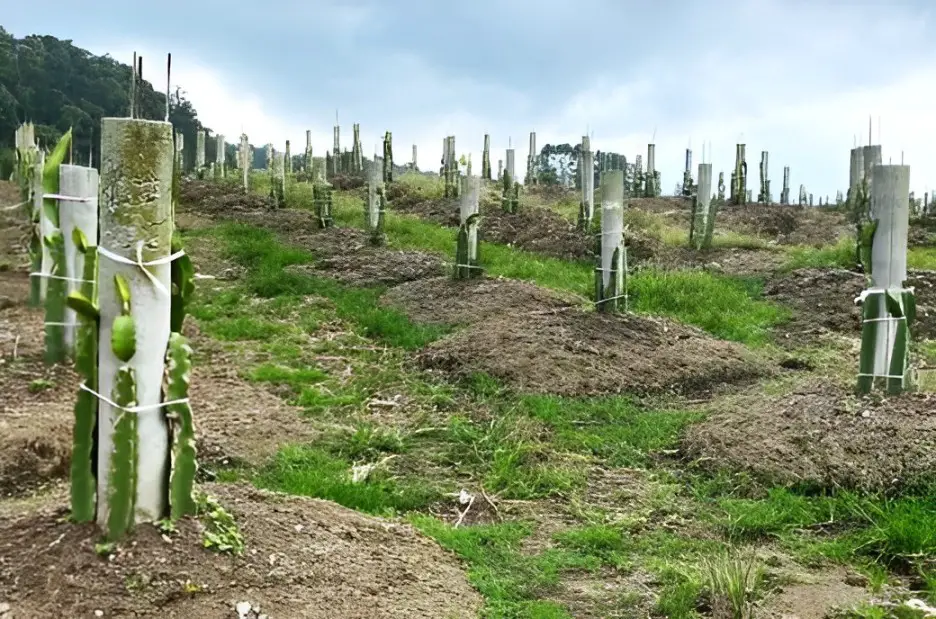Dragon fruit cultivation is rapidly growing in India, with many farmers experimenting with this unique fruit in their fields. The plant’s vibrant, exotic appearance and delicious taste have led to an increase in its demand, making it an attractive option for farmers looking to diversify their crops. However, as with any new venture, it is essential to understand the best practices for planting and maintaining dragon fruit plants. One of the most critical aspects of this process is choosing the Best Time to Plant Dragon Fruit. Let’s delve into the details.
Best Time to Plant Dragon Fruit New plantation

Dragon fruit, scientifically known as Hylocereus undatus, is a cactus species that thrives in warm climates. While the plant is quite adaptable, selecting the right planting time is crucial for ensuring healthy growth and a bountiful harvest. In India, dragon fruit can be planted at different times of the year, but the Best Time to Plant Dragon Fruit and most optimal periods are between February to March and July to August.
Dragon fruit plantation: Why February to March is Ideal
Perfect Temperature Conditions
The months of February to March offer moderate temperatures—neither too cold nor too hot—creating a balanced environment for the dragon fruit plant. During this time, the soil is neither too wet nor too dry, allowing the plant’s roots to establish strong connections with the soil.
Protection from Winter Chill
In northern parts of India, the temperature begins to rise after the cold winters, making this an excellent time for plantation. Dragon fruit plants are sensitive to cold temperatures and typically enter a dormancy phase when the weather turns too chilly. Planting in early spring ensures that they are well established before the intense summer heat sets in.
Rapid Growth Phase
In the spring, the dragon fruit plant’s roots grow quickly, and the branches begin to form strong structures. This early growth ensures the plants are well-prepared for fruiting in the following year, making February to March the perfect period for planting.
Benefits of Planting in July to August

Rainy Season Advantage
The July to August period coincides with the monsoon season in India. The consistent rainfall during this time keeps the soil moist, allowing the plant’s roots to develop effectively. Moreover, the natural watering from rainfall reduces the need for manual irrigation, saving both water and effort for the farmer.
Nutrient-Rich Soil
The rain during these months also helps bring vital nutrients from the deeper layers of the soil to the surface. This nourishment ensures that the plants grow stronger and healthier. Also, the cool and humid weather conditions allow the plant to flourish without facing extreme heat stress.
Better Root Development
dragon fruit plantation in the monsoon season, dragon fruit plants benefit from the continuous, mild rain showers, which encourage root growth and faster establishment. These plants will be well on their way to thriving by the time the dry season sets in.
Key Factors to Consider Before Plantation

Choose the Right Variety
dragon fruit new growth – Before planting, it’s important to know which variety of dragon fruit will suit your local climate best. The most common varieties in India are Hylocereus undatus, Hylocereus costaricensis, and Hylocereus megalanthus. Testing different varieties according to your region’s weather will help determine the best type for you.
Soil Requirements
Dragon fruit plants require well-draining, slightly acidic soil to thrive. The soil should be rich in organic matter to support plant growth. If your soil is clay-heavy, adding compost or organic fertilizers will improve drainage and ensure healthy plant development.
Plantation Tips for New Farmers
- Use Raised Beds: dragon fruit plantation – When planting dragon fruit, it is advisable to raise the beds to improve drainage. This protects the plants’ roots from waterlogging, which can lead to rot.
- Spacing: Ensure proper spacing between plants (about 3-4 feet apart). This allows each plant sufficient space to grow without competition for nutrients and light.
- Irrigation: While dragon fruit plants are drought-resistant, they still require regular watering. However, ensure that the soil is not waterlogged, as excessive water can harm the plant.
- Protection from Wind: Dragon fruit plants are tall and can be sensitive to strong winds. Use windbreaks or plant them near fences to protect them.
Tip of the Day: Best Practices for Dragon Fruit Care
Tip of the Day: Dragon Fruit Pruning for Better Yield
Pruning is one of the most important tasks for dragon fruit new growth. While the plant is relatively low-maintenance, regular pruning ensures that the plant remains healthy and produces high-quality fruit. Best Time to Plant Dragon Fruit Here’s how you can improve your dragon fruit yield with proper pruning:
- Remove Dead or Weak Branches:
Always cut off dead or unhealthy branches. This will prevent disease from spreading and allow the plant to focus its energy on healthy, productive branches. - Encourage New Growth:
Pruning can help stimulate new growth, which will eventually lead to better fruit production. Cut back some of the older, longer stems, as new branches will grow from these points. - Create a Balanced Structure:
Ensure the plant’s structure is balanced by trimming branches that may be growing in an undesirable direction. This will make the plant more stable and less prone to damage from wind or heavy rains. - Shape the Plant for Easier Harvesting:
The dragon fruit plant grows in a vine-like manner, so it’s important to prune the branches into a manageable shape. This makes it easier to harvest the fruit and maintain the plant.
Regular pruning not only encourages better air circulation but also promotes the growth of new flowers, which eventually turn into fruit. With the right balance of pruning, water, and sunlight, your dragon fruit plants will thrive, leading to a fruitful harvest year after year.
Frequently Asked Questions (FAQ)
Q1: Can Dragon Fruit be Planted in May or June?
Answer: Best Time to Plant Dragon Fruit – May and June are typically very hot months in most parts of India, with temperatures often rising above 40°C. Planting during this time is not recommended, as the heat can stress the plants, hindering growth and development.
Q2: Can Dragon Fruit be Planted in Winter?
Answer: Dragon fruit plants are not cold-resistant and will struggle if the temperature drops below 10°C. In colder climates, planting in winter can cause the plants to go dormant, halting growth. It’s better to plant during the warmer months.
Q3: What If it Rains Immediately After Planting?
Answer: If it rains after planting, there is no need to worry. As long as the soil is well-drained, the plants will benefit from the rainwater. However, ensure that the raised beds you plant in have good drainage to avoid waterlogging.
Q4: Should Dragon Fruit Cuttings be Planted Directly or Rooted First?
Answer: It’s advisable to root dragon fruit cuttings first before planting. This allows the plant to develop a strong root system before being exposed to the soil.
Q5: What Are the Ideal Soil Conditions for Dragon Fruit?
Answer: Dragon fruit prefers well-drained, slightly acidic soil (pH 6-7). The soil should also be rich in organic matter to support healthy growth.
Q6: Can I Grow Dragon Fruit in Containers?
Answer: Yes, dragon fruit can be grown in containers, especially if you have limited space. Choose a large container with good drainage to allow the plant to spread its roots.
Q7: How Long Does It Take for Dragon Fruit to Fruit?
Answer: Dragon fruit plants generally start producing fruit after 12-18 months of planting, depending on the variety and care provided.
Q8: Is Dragon Fruit Resistant to Pests and Diseases?
Answer: While dragon fruit is relatively resistant to pests, it can be affected by fungal diseases and mealy bugs. Regular care and maintenance can help prevent such issues.
Q9: How Much Sunlight Does Dragon Fruit Need?
Answer: Dragon fruit requires full sunlight for at least 6 hours a day to thrive. However, it can tolerate partial shade as well.
Q10: What Is the Best Fertilizer for Dragon Fruit?
Answer: A balanced fertilizer with equal amounts of nitrogen, phosphorus, and potassium (NPK) is ideal for dragon fruit. Organic compost and manure can also be used for added nourishment.
Choosing the right time for planting dragon fruit is essential for successful cultivation. If the timing is not correct, it can lead to reduced fruiting and slower growth the following year. The growth and yield of the plant depend heavily on the right conditions being met at the right time. Therefore, it is important to pay close attention to the timing of planting. Timing plays a significant role in the success of any agricultural practice.
By following this comprehensive guide, Best Time to Plant Dragon Fruit you can ensure that your dragon fruit plantation flourishes, yielding high-quality fruits and maximizing your harvest potential.
If you have any question regarding this do let me know in the comment section below!
and do follow these steps for the maximum results.

